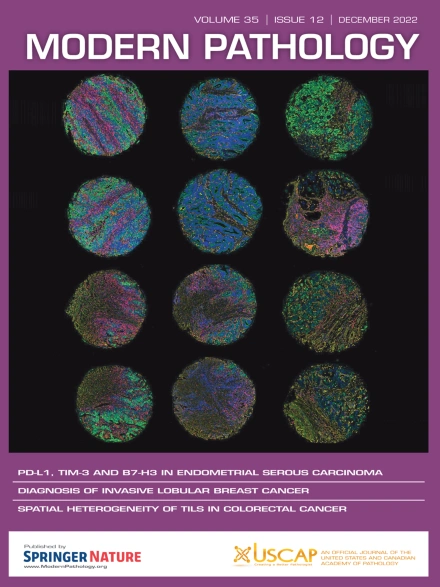基因组分析揭示了更广泛的皮肤纤维肉瘤隆突:诊断和治疗的意义。
IF 7.1
1区 医学
Q1 PATHOLOGY
引用次数: 0
摘要
皮肤纤维肉瘤隆突(DFSP)是一种局部侵袭性皮肤肿瘤,由PDGFB或罕见的PDGFD基因融合驱动。在某些情况下,DFSP发展为具有转移潜力的纤维肉瘤形式,可能对酪氨酸激酶抑制剂有反应。本研究探讨了全面的基因组分析是否可以揭示DFSP更广泛的临床、解剖和病理谱。利用大型肿瘤测序参考实验室的数据库,我们鉴定了PDGFB或PDGFD融合的肿瘤,并回顾了它们的组织学特征、临床信息、外显子组测序数据和拷贝数改变。采用Mann-Whitney U和Fisher的精确检验确定统计显著性。共鉴定出59例PDGFB或PDGFD融合:55例COL1A1::PDGFB, 3例EMILIN2::PDGFD, 1例COL1A2::PDGFB。该队列包括51例原发肿瘤和8例转移瘤(31例男性,28例女性,中位年龄49岁)。原发性肿瘤主要位于皮肤及软组织,其中躯干35例,头颈部9例,四肢9例。此外,6例肿瘤发生在内脏器官(子宫4例,宫颈1例,肺1例)。在病理检查的载玻片中,21例为典型DFSP, 31例为纤维肉瘤性DFSP (FS-DFSP)。值得注意的是,21个肿瘤(36%)最初被错误分类,通常是由于不典型的位置或组织学。FS-DFSPs显示出比PDGFB/PDGFD更高的基因组改变发生率(75%对23.8%,p=0.0005),包括TERT启动子和NF1变异,并显示出显著升高的肿瘤突变负担(p=0.0037)和TERT mRNA表达(1.27对0.13转录/百万,p=0.0005)本文章由计算机程序翻译,如有差异,请以英文原文为准。
Genomic Profiling Uncovers a Broader Spectrum of Dermatofibrosarcoma Protuberans: Implications for Diagnosis and Therapy
Dermatofibrosarcoma protuberans (DFSP) is a locally aggressive cutaneous neoplasm driven by PDGFB or, rarely, PDGFD gene fusions. In some cases, DFSP progresses to a fibrosarcomatous form with metastatic potential, which may respond to tyrosine kinase inhibitors. This study explores whether comprehensive genomic profiling can reveal a broader clinical, anatomic, and pathologic spectrum for DFSP. Using the database of a large tumor sequencing reference laboratory, we identified tumors with PDGFB or PDGFD fusions and reviewed their histologic features, clinical information, exome sequencing data, and copy number alterations. Statistical significance was determined using Mann-Whitney U and Fisher exact tests. A total of 59 cases with PDGFB or PDGFD fusions were identified: 55 COL1A1::PDGFB, 3 EMILIN2::PDGFD, and 1 COL1A2::PDGFB. The cohort included 51 primary tumors and 8 metastases (31 males, 28 females, median age 49 years). Primary tumors were mainly located in the skin and soft tissues, including 35 in the trunk, 9 in the head and neck, and 9 in the extremities. Additionally, 6 tumors arose in visceral organs (4 in the uterus, 1 in the cervix, and 1 in the lung). Among cases with slides available for pathology review, 21 were classified as classic DFSP and 31 as fibrosarcomatous-DFSP (FS-DFSP). Notably, 21 tumors (36%) were initially misclassified, often due to atypical locations or histology. FS-DFSPs displayed a higher incidence of genomic alterations beyond PDGFB/PDGFD (75% vs 23.8%; P = .0005), including TERT promoter and NF1 variants, and demonstrated a significantly elevated tumor mutational burden (P = .0037) and TERT mRNA expression (1.27 vs 0.13 transcripts per million; P < .0001) compared with classic DFSPs. These findings underscore the value of genomic profiling for recognizing FS-DFSPs with unusual clinical or histologic features, particularly in guiding targeted therapy. Furthermore, by identifying molecular features specific to fibrosarcomatous variants, such as TERT reactivation, this study offers insights into potential molecular drivers of tumor progression in DFSP.
求助全文
通过发布文献求助,成功后即可免费获取论文全文。
去求助
来源期刊

Modern Pathology
医学-病理学
CiteScore
14.30
自引率
2.70%
发文量
174
审稿时长
18 days
期刊介绍:
Modern Pathology, an international journal under the ownership of The United States & Canadian Academy of Pathology (USCAP), serves as an authoritative platform for publishing top-tier clinical and translational research studies in pathology.
Original manuscripts are the primary focus of Modern Pathology, complemented by impactful editorials, reviews, and practice guidelines covering all facets of precision diagnostics in human pathology. The journal's scope includes advancements in molecular diagnostics and genomic classifications of diseases, breakthroughs in immune-oncology, computational science, applied bioinformatics, and digital pathology.
 求助内容:
求助内容: 应助结果提醒方式:
应助结果提醒方式:


